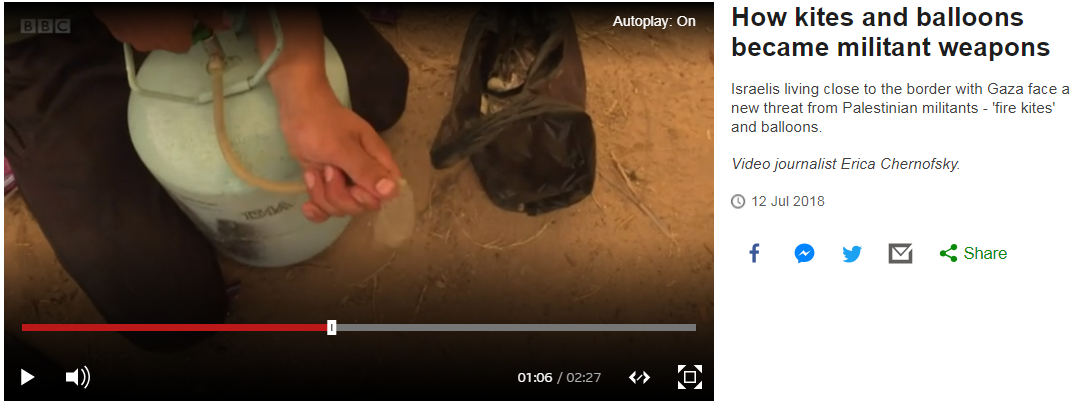In recent weeks we have been documenting the BBC’s coverage – or lack of it – of the arson attacks on farmland, woodland and nature reserves adjacent to the Gaza Strip.
BBC News yawns at ‘Great Return March’ arson incidents
BBC News makes a story disappear by changing photo captions
BBC News finally mentions Gaza arson attacks – in just sixteen words
Comparing BBC coverage of fires in England and Israel
After three months, BBC News website notices Gaza arson attacks
As was noted on several occasions during that time:
“Since they began in April, not one BBC Jerusalem bureau reporter has found the time to travel to the border district to report on how the attacks are affecting the people living there.”
Apparently somebody at the BBC also noticed that fact because on July 12th a filmed report by Erica Chernofsky appeared on the BBC News website’s Middle East page under the headline “How kites and balloons became militant weapons“.
Although the arson attacks had been going on for three months by the time this video appeared, they were described as a “new threat” in its synopsis. [emphasis added]
“Israelis living close to the border with Gaza face a new threat from Palestinian militants – ‘fire kites’ and balloons.”
In just over half of the two-minute twenty-seven second video viewers hear from Yael Raz Lachiani – spokesperson for Kibbutz Nahal Oz. In the rest they are told by the BBC that:
“Palestinian militants in Gaza are using some unusual weapons to attack Israel. These rudimentary weapons have caused more than 500 fires in the area. The balloons are often made from condoms because of their durability.”
At that point viewers see footage of such a balloon being filled with some sort of gas.

They are not told that the gas is helium and that it is intended to be used for medical purposes – notably MRI machines – or that last month Israel announced that it would “be more critical in assessing the requests made by hospitals and medical facilities in the Gaza Strip to ensure that the gas was being used for the correct purposes and not for arson balloons”.
The video goes on:
“More than 6,000 acres of land have been destroyed by the fires.”
In fact, over a week before this video was published the figure was already over 7,400 acres.
“In Nahal Oz, some 250 acres of wheat fields have been scorched. The damage is estimated to be about $2m (£1.5m). The attacks began amid a period of violence along the border which saw about 120 Palestinians killed.”
No context concerning the pre-planned nature of that “period of violence”, the part played by terror groups in initiating, facilitating and financing it or the fact that over 80% of those “120 Palestinians” were linked to terror factions was provided to viewers, who were then told that:
“The Israeli army has developed drone technology to down the kites but it doesn’t catch them all.”
So finally, after three months of arson attacks, members of the BBC’s audience who happened to visit its website may now have seen one minute and twenty seconds of comment from one resident of the area bordering the Gaza Strip.




